PHOTOS | From barn to boardroom: BBA students explore livestock markets for seaweed
Topics
Featured
Share online
An early summer breeze sweeps over a freshly cut hay field as Lorraine Buchanan drives her tractor toward nine awaiting Bachelor of Business Administration in Innovation and Sustainability students.
Together with her husband John, Lorraine Buchanan owns and operates Parry Bay Sheep Farm in Metchosin. Today, she’s busy preparing a familiar meal for the herd — but the visiting students are here to explore something far less familiar to the sheep: seaweed.
As the tractor blades whirr to a stop, the faint sounds of bleating carry from a nearby pasture, offering a soundtrack to today’s research interview.
The students are working with Sidney-based client, Cascadia Seaweed, a local company that cultivates seaweed in the ocean in partnership with Indigenous communities along the coast of BC.
Today’s assignment is to visit two different farms in the region to launch a four-week process of primary and secondary research. During that time, three groups of students will interview farmers and feed suppliers across the region and gather critical information to make recommendations about target markets, pricing, distribution and more.
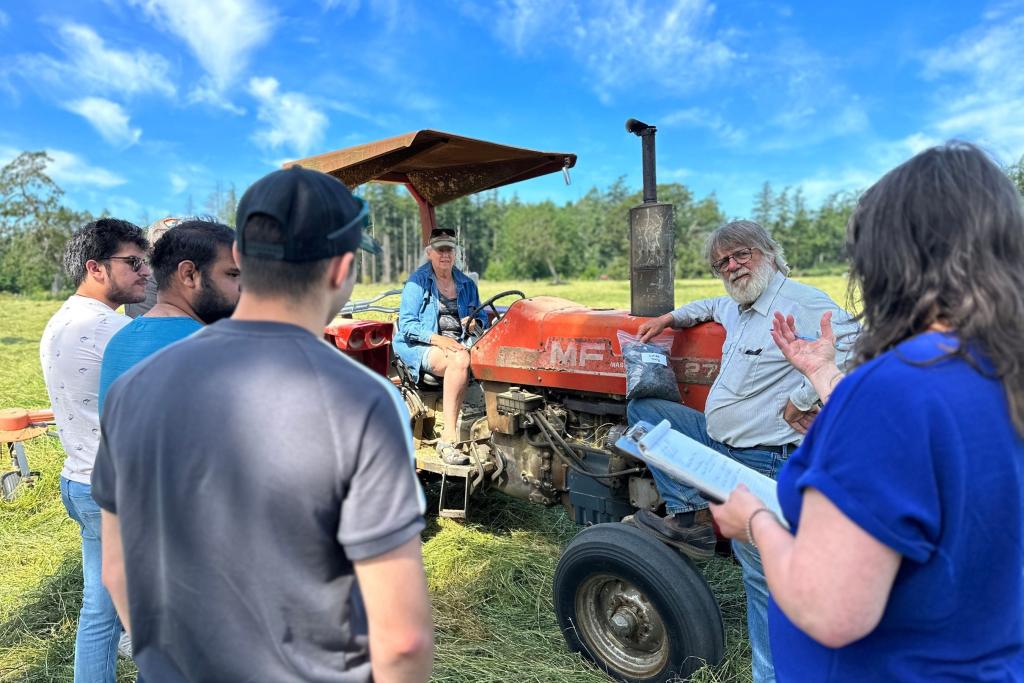
Parry Bay Sheep Farm owners Lorraine and John Buchanan, first generation farmers since 1985, speak with students about their farming needs, challenges and feeding practices.
“Cascadia produces a liquid [extract] that’s used by farms as a natural fertilizer,” explains student Pratham Khowala to the Buchanan’s.
Essentially, once the juices are squeezed out, what remains can be dried, ground, powdered or pelletized for animal feed or additives, he says.
The students are tasked with finding out what the market potential is for this product. Could and would farmers use it? And what are their potential barriers to accessing it?
Cascadia’s trials have shown that sugar kelp has the potential to not only increase meat and milk production in cattle, but it can also reduce the methane emissions from the cattle by up to 10 to 15 percent.
John inspects the sample the students have brought along, snapping the cracker-sized flakes between his fingers.
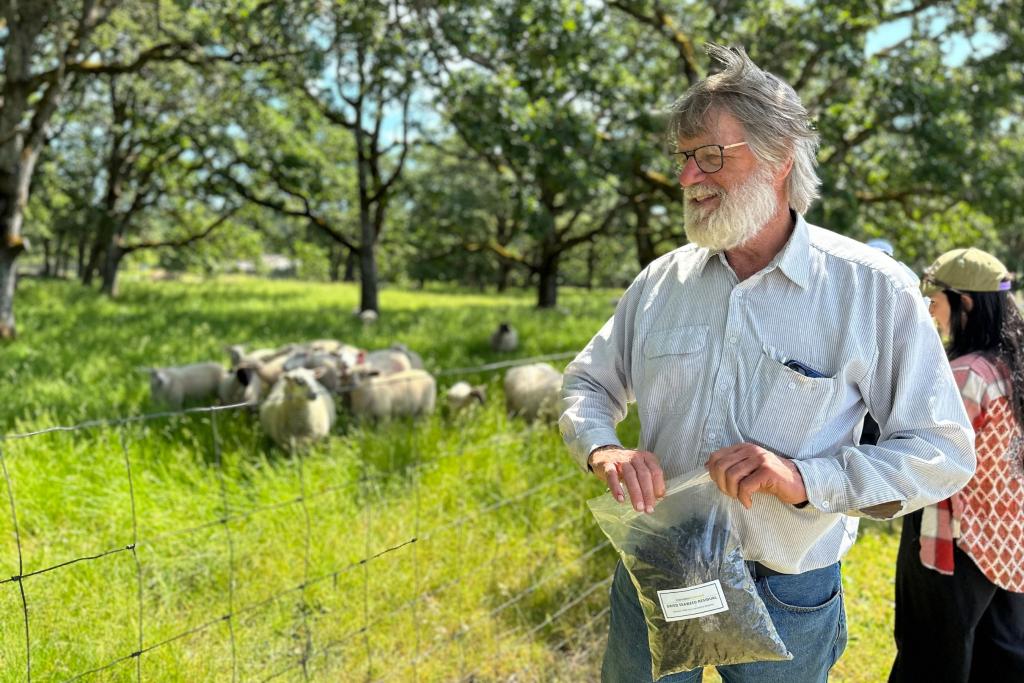
Sheep need selenium in their diet but local grasses contain low levels and too much can be toxic. So nutritional supplements need to be well balanced, the Buchanans explain.
“We need to know the exact mineral content in it,” says Lorraine. “How much selenium is in it?” she wonders, noting that mineral composition is important. “We feed a trace mineral salt to our sheep. We’d have to balance [the seaweed] with what we’re already giving them.”
The students learn that sheep need both selenium and copper but they’re also both toxic at high levels – important information to take back to their client for consideration.
And even if the nutrients check out, there’s still one big question: will the sheep actually eat it?
“The palatability will be really important,” Lorraine says, adding that that it takes time for their rumens — the specialized stomachs unique to cows, sheep, and goats — to adapt to the change.
“We can do a taste test,” John says.
He leads the students to his grazing herd, and with a few sharp claps, they excitedly come running.
He offers a bite to the first in line, who takes the sample without hesitation and is even curious enough for a second bite.
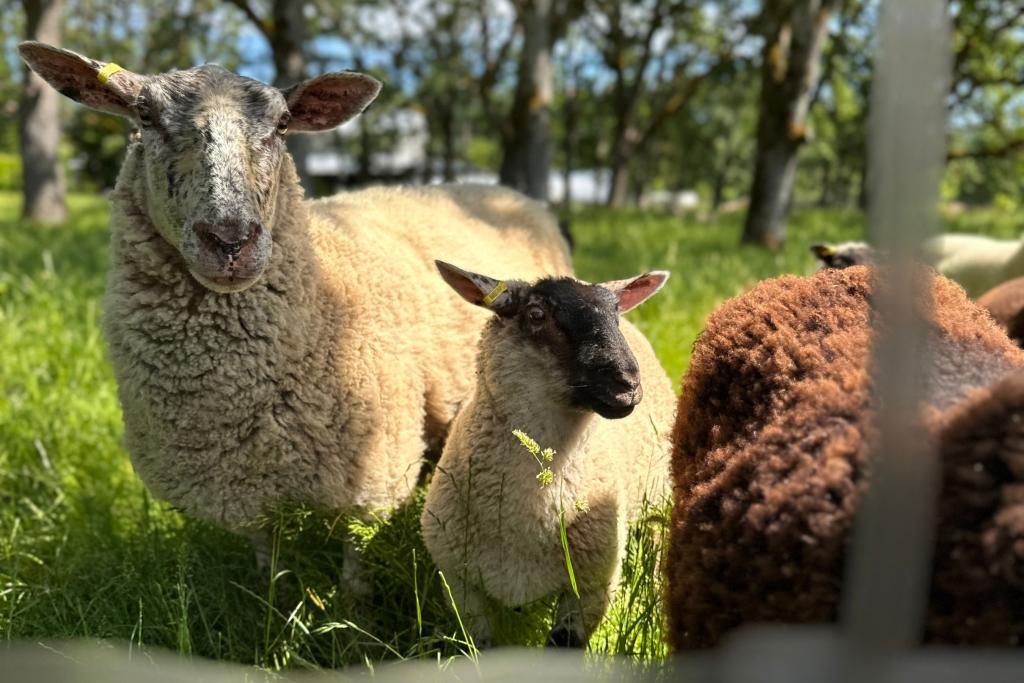
Some of the Buchanan's 220 sheep peek through the fence for the chance to try a seaweed sample.
Royal Roads University adjunct professor and ecological economist Gillan Kerr is facilitating the project with the students.
She says the BBA in Innovation and Sustainability is a unique program that gives students the chance to work with live clients from local businesses, nonprofits, and government to solve real challenges that matter.
“This is Cascadia’s opportunity to be as sustainable as possible,” Kerr says. “The idea is that seaweed that’s sustainably harvested at five First Nations farms in partnership means that there’s more land that could be arable in the future that right now is going to crops.”
Cascadia knew there was potential in the agri-feed market, Kerr says, but what they didn’t have was the time or resources to validate their assumptions.
So they reached out to RRU for help.
The second stop of the day is Stillmeadow Farm to speak with co-owner Tom Henry about his pig farming business.
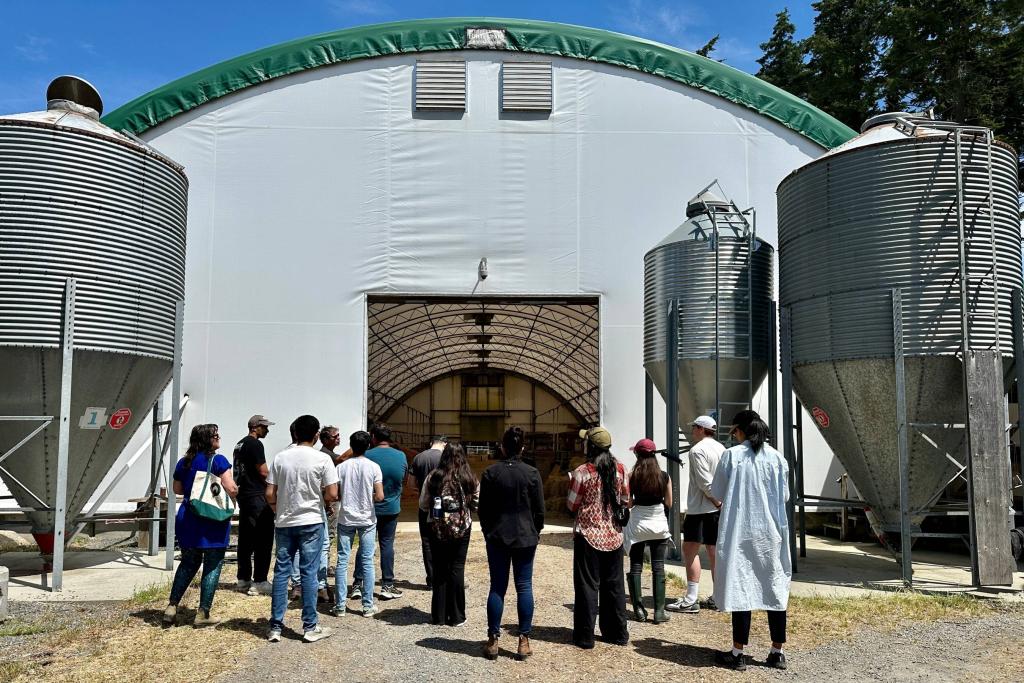
Stillmeadow Farm owner Tom Henry tours students through his pig barn, home to about 350 animals. Feed containers, seen to the left and right, distribute one tonne of food per day through an automated system.
After giving students a tour of the 14,000 square foot barn – and the chance to meet some of his 50 sows and their newest additions – he enlists their help to build an impromptu seating area out of hay bales.
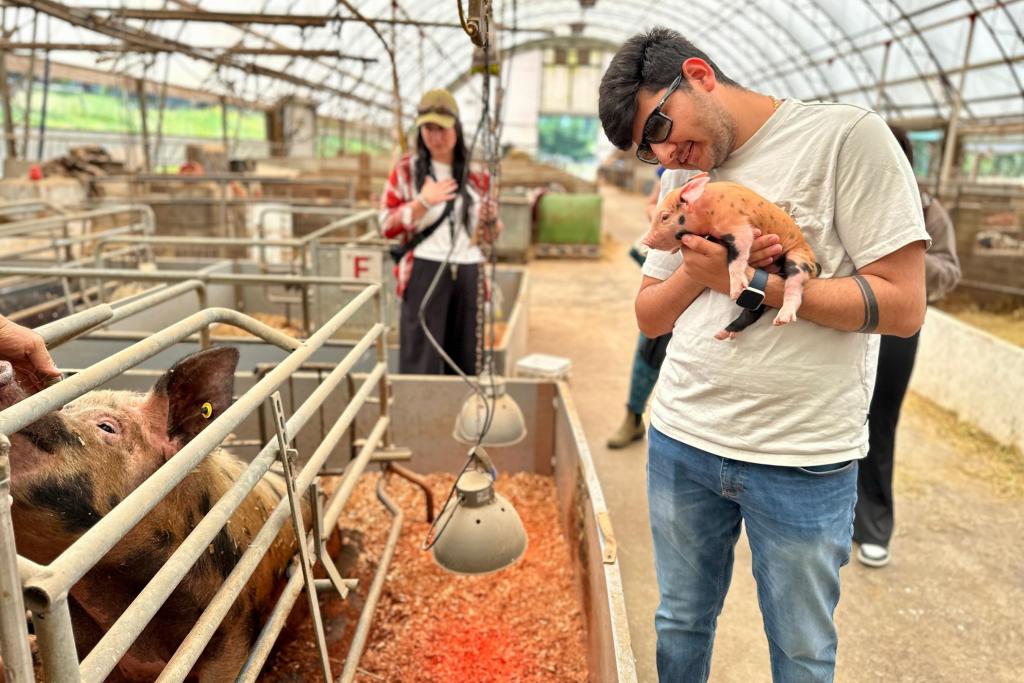
This six-day old piglet will grow to about 250 pounds in six months.
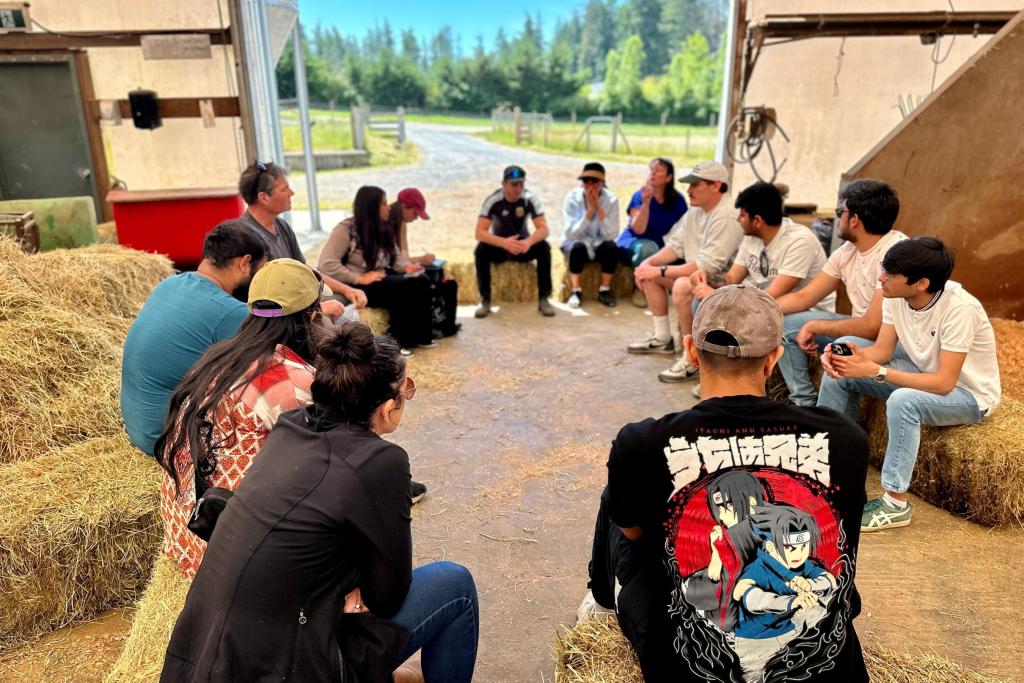
Henry runs one of the few pig farms on Vancouver Island. “My feed is nutritionally complete and it comes in a form that’s very friendly for the feeding systems,” he tells students. “In some ways, [the seaweed] is up against a perfect feed.”
Henry explains that his pigs need a very particular balanced feed.
“When you go from a pound and a half to 250 pounds in six or seven months, you need an extraordinarily fine-tuned diet,” one he says he currently already has from his provider.
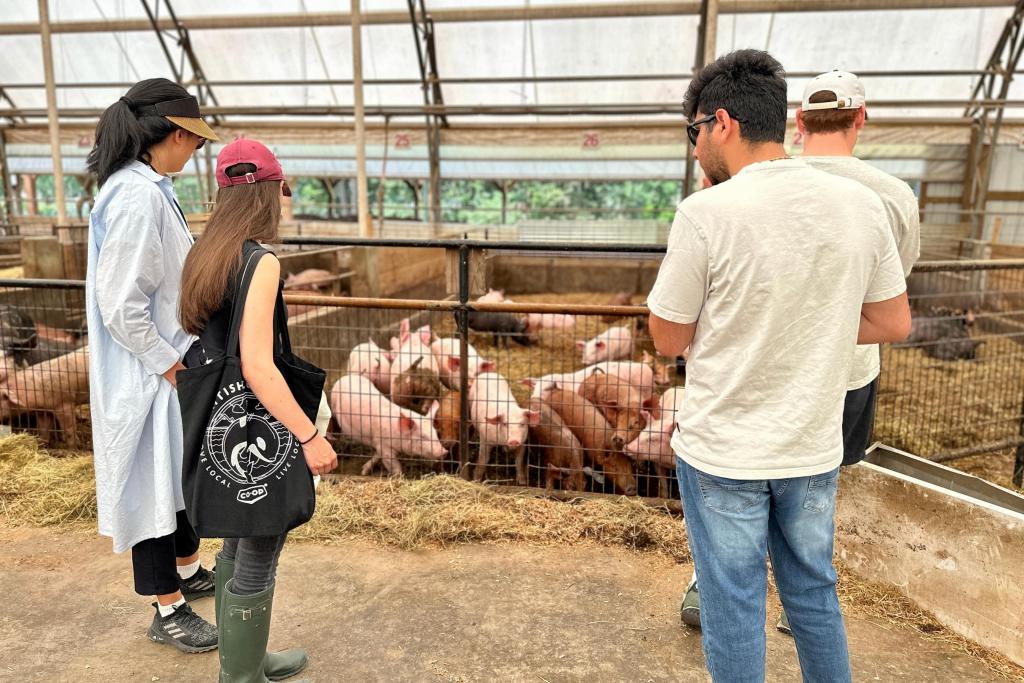
“Maybe one of your conversations should be with Top Shelf feeds,” he offers the students, explaining that anything he gives his pigs must be compatible with his automated feeding system – anything not pelletized will clog the pipes.
“Top Shelf sells many thousands of tonnes of feed. So is there possibility getting it in there?” he says.
Kerr says projects like this, and the chance to connect with real potential customers like Henry, are invaluable because they give students a connection to what’s happening in the real world.
Sanskriti Shetty says that’s exactly what drew her to the program.
“We’re not doing exams,” she says. We’re working with real clients, so we’re building those skills. That’s what we need for our futures.”
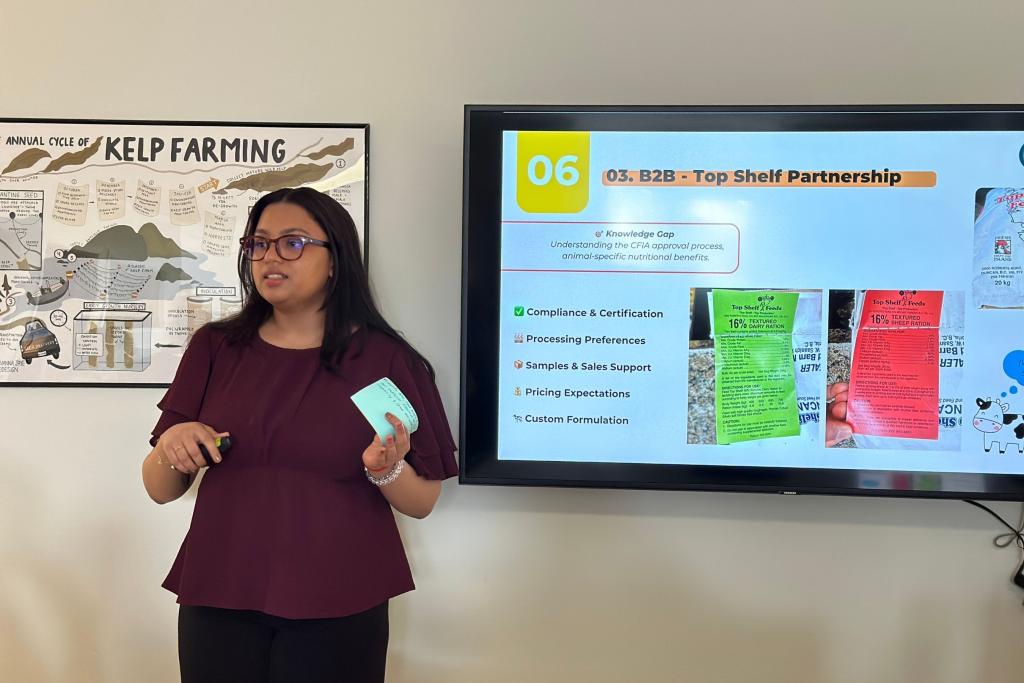
Sanskriti Shetty shares some of her team’s findings and recommendations during final presentations to Cascadia Seaweed. “When we spoke to farmers, their main goal is if it has nutritionists' approval," she said. “Performance is the priority.”
Shetty says the hands-on program will help her broaden her options, allowing her to get real experience in various industries.
The changemaking aspect of the program was also a big draw for her.
“We can make a difference in any industry that we choose, and that’s what Royal Roads is helping us learn,” she says.
That focus – on innovation and sustainability – was also key for student Muhammad Awais.
“The world is changing,” he says, referring to the climate crisis. All these problems come from us. So now if we can do something better, we should.”
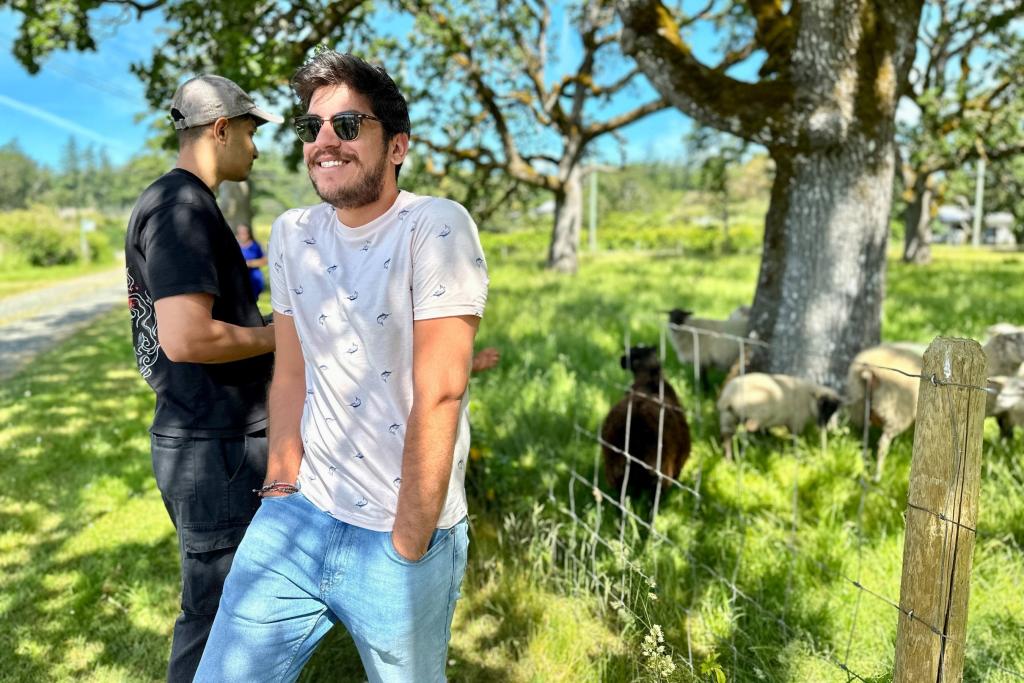
"What attracted me to the BBA was that it had innovation and sustainability in it," says Muhammad Awais.
The BBA program doesn’t just equip students to help the planet through its focus on sustainability — it also gives them a career edge through hands-on, project-based learning, says Lee Sentes, BBA program head.
“Our graduates have such a leg up,” he says. “Our program focuses on the soft skills that employers actually want. They’ve told us they want problem solvers, people who can work together, people who are confident that they can deal with unknowns and come out with something useful in the end.”
While he says the students don’t always solve every problem they’re tasked with, that doesn’t mean there isn’t value for the client.
“Everyone comes out of this process saying, ‘wow, I’m seeing my problem in a different light.’ And even if we can do that, that’s a huge benefit.”
And the students gain critical, real-world knowledge too, Sentes says, noting that none of the students knew anything about seaweed, farming or the agri-feed supply chain at the beginning of the project.
“The depth of learning that comes from saying to students, ‘our client has no contacts with farmers so you are going to have to go out and get those contacts.’ I’m just eternally amazed at the students just going out and doing it. They’re rock stars doing it quickly and at such quality.”
After hearing the students' final presentations, Cascadia Communications Manager Erin Bremner-Mitchell says the experience was valuable.
“As an early-stage company, we didn’t have the resources to take this on ourselves,” she says. “I was really hoping to validate our assumptions about the agri-feed market — either to confirm that we don’t have enough biomass to supply the cattle feed market, or to show that we do and explore how. Or perhaps even uncover a supplementary market we hadn’t yet considered.
“The feedback, especially on selenium, was really useful. I’m excited to speak with the team after this and figure out the next steps for us.”